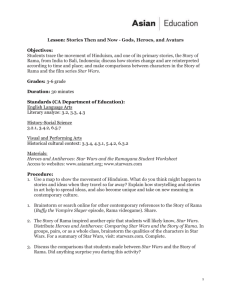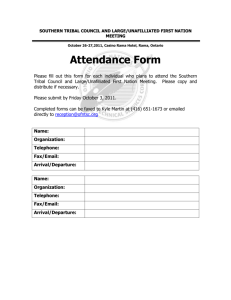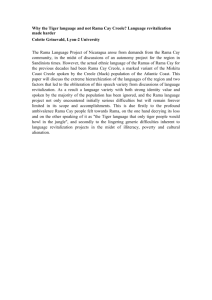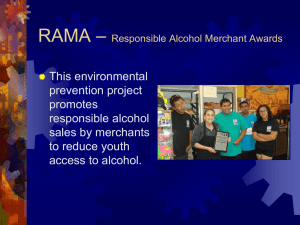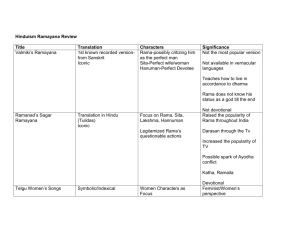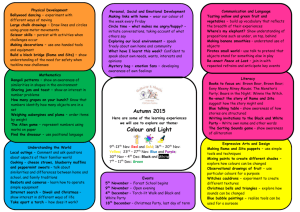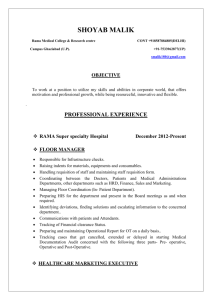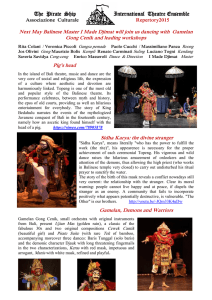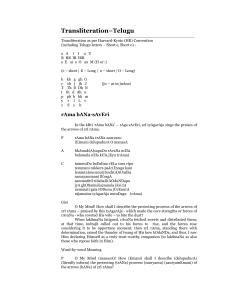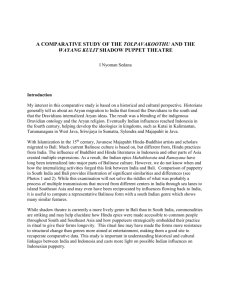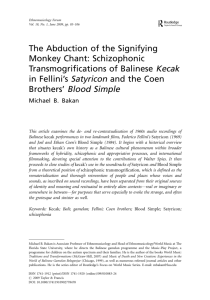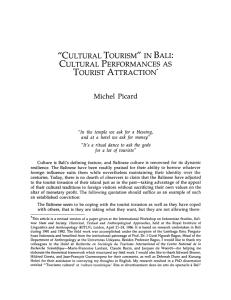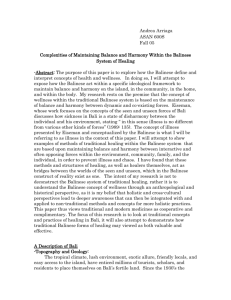Lesson: Good and Evil: Dynamic Opposites ()
advertisement
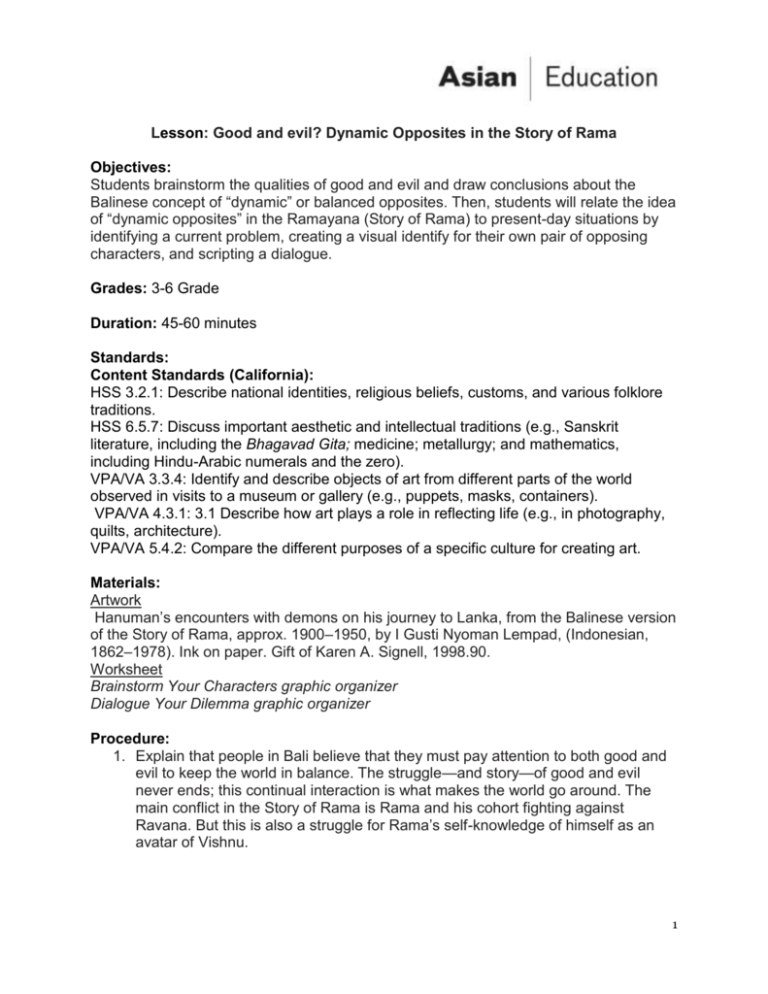
Lesson: Good and evil? Dynamic Opposites in the Story of Rama Objectives: Students brainstorm the qualities of good and evil and draw conclusions about the Balinese concept of “dynamic” or balanced opposites. Then, students will relate the idea of “dynamic opposites” in the Ramayana (Story of Rama) to present-day situations by identifying a current problem, creating a visual identify for their own pair of opposing characters, and scripting a dialogue. Grades: 3-6 Grade Duration: 45-60 minutes Standards: Content Standards (California): HSS 3.2.1: Describe national identities, religious beliefs, customs, and various folklore traditions. HSS 6.5.7: Discuss important aesthetic and intellectual traditions (e.g., Sanskrit literature, including the Bhagavad Gita; medicine; metallurgy; and mathematics, including Hindu-Arabic numerals and the zero). VPA/VA 3.3.4: Identify and describe objects of art from different parts of the world observed in visits to a museum or gallery (e.g., puppets, masks, containers). VPA/VA 4.3.1: 3.1 Describe how art plays a role in reflecting life (e.g., in photography, quilts, architecture). VPA/VA 5.4.2: Compare the different purposes of a specific culture for creating art. Materials: Artwork Hanuman’s encounters with demons on his journey to Lanka, from the Balinese version of the Story of Rama, approx. 1900–1950, by I Gusti Nyoman Lempad, (Indonesian, 1862–1978). Ink on paper. Gift of Karen A. Signell, 1998.90. Worksheet Brainstorm Your Characters graphic organizer Dialogue Your Dilemma graphic organizer Procedure: 1. Explain that people in Bali believe that they must pay attention to both good and evil to keep the world in balance. The struggle—and story—of good and evil never ends; this continual interaction is what makes the world go around. The main conflict in the Story of Rama is Rama and his cohort fighting against Ravana. But this is also a struggle for Rama’s self-knowledge of himself as an avatar of Vishnu. 1 2. Rama must constantly defeat Ravana. The people in Bali view this idea that noble and evil are necessary for the universe to have balance as “dynamic opposites.” 3. What are some examples of dynamic opposites? (day/night, yin/yang, ocean/mountain). 4. Project: Hanuman’s encounters with demons on his journey to Lanka. Ask if they can identify what part of the story is depicted and provide evidence. Then, discuss who looks noble, who looks evil, and provide evidence based on what they see. Explain that Kumbhakarna didn’t want to fight against Rama, but chose to out of loyalty for his brother, Ravana. Ask students to share examples of a time when they got in trouble for doing something they thought was the right thing to do. 5. Brainstorm the characteristics of a noble and evil character. Ask: How would a noble character in our culture look and act? How would an evil character in our culture look and act? 6. Distribute Brainstorm Your Characters. Have the students—singly or in pairs— identify a problem in the world today. Their characters will be part of this struggle. Then, have students design their own pair of opposing characters based on the problem they identified. 7. Have students each choose one character to develop visually for their shadow puppet, and start sketching their character to illustrate the characteristics expressed in the graphic organizer. Students can work alone or in pairs. 8. Distribute Dialogue Your Dilemma and have pairs write some dialogue between their characters talking about their conflict. Write at least two lines for each character. Make sure they are talking about the problem in some way! Further Research: Translations: Goldman, Robert P. The Ramayana of Valmiki, Princeton Library of Asian Translations. Princeton: Princeton University Press, 1990. For Students: Clevaland Beech, Milo. The Adventures of Rama: With illustrations from a 16th Century Mughal Manuscript. Washington, DC: Smithsonian Books, 1983, forthcoming reprint by Mapin Publishing, 2011. Cox, David. Ayu and the Perfect Moon. London: Bodley Head Children’s Books, 1984. Mason, Victor, with Gillian Beal. Balinese Children’s Favorite Stories. North Clarendon: Tuttle Publishing, Periplus Editions, 2001. Weitzman, David. Rama and Sita: A Tale of Ancient Java. Boston: David Godine, 2002. 2 For Teachers: Burton, Richard T. Hindu Art. London: British Museum Press, 1992. Dibia, Wayan, and Rucina Ballinger. Balinese Dance, Drama, and Music: A Guide to the Performing Arts of Bali. North Clarendon: Tuttle Publishing, Periplus Editions, 2004. Dibia, I Wayan. Kecak: The Vocal Chant of Bali. Denpasar: Hartano Art Books, Bali.1996. Eiseman, Fred. Sekala and Niskala, Volumes I and II. North Clarendon: Tuttle Publishing, Periplus Editions, 1989. Kam, Garrett. Story of Rama in the Arts of Asia. Singapore: Select Books, 2000. Richman, Paula, ed. Many Story of Ramas: The Diversity of a Narrative Tradition in South Asia. Berkeley: University of California Press, 1991. Richter, Anne. Arts and Crafts of Indonesia. London: Thames & Hudson, 1993. Tenzer, Michael. Balinese Music. North Clarendon: Tuttle Publishing, Periplus Editions, 1991. Local Organizations Gamelan Sekar Jaya, www.gsj.org: A Bay Area music and dance group specializing in Balinese music; the sixty-member group performs, gives workshops and classes, and hosts master guest artists from Bali. ShadowLight Productions, www.shadowlight.org: A San Francisco-based theater company that integrates Balinese forms of shadow puppetry and storytelling with modern production techniques. Larry Reed, artistic director, is a shadow puppeteer who translates Balinese puppetry for English-speaking audiences. (His film Shadow Master is recommended for ages 8 and up.) KQED Spark has an educators guide on ShadowLight. http://www.shadowlight.org/slp/docs/Spark-EducatorGuide.pdf Online Resources Office of Resources for International and Area Studies (ORIAS), University of California, Berkeley, orias.berkeley.edu: “The Story of Rama in Southeast Asia.”. Kecak performance of the Story of Rama, www.youtube.com/watch?v=CX1rghsOqu0&feature=fvw Gamelan Sekar Jaya’s I Putu Putrawan and Wayne Vitale playing interlocking gamelan patterns from the piece Teruna Jaya: www.youtube.com/watch?v=7y771-AxrFA Interlocking drumming pattern: www.youtube.com/watch?v=wlY2DiwEghQ&NR=1 Center for Southeast Asian Studies, Northern Illinois University, www.seasite.niu.edu: Summary of the Indonesian Story of Rama, audio files in Indonesian, and Javanese temple reliefs. Performance of interlocking parts by Balinese musician I Putu Putrawan and Wayne Vitale, http://www.youtube.com/watch?v=7y771-AxrFA. 3 4
